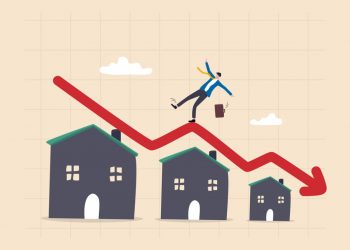RISMEDIA, May 7, 2008-Home values in the first quarter of 2008 fell 1.6% from the fourth quarter and 7.7% from the year-ago quarter, marking the most significant year-over-year decline in the past 12 years, to a U.S. Zindex® home value indicator of $213,000, according to the Zillow.com Q1 Home Value Report released this week. The median U.S. home value has not been this low since the second quarter of 2005, which has caused more recent homeowners to fall into negative equity4 situations than during any quarter previously documented.
According to the company, Zillow® expanded its Home Value Report this quarter to cover 160 metropolitan statistical areas (MSAs) and added a supplemental report for its top 30 MSAs that identifies when home values were last at first quarter levels, when each market peaked and the percentage of decline since the peak. With the exception of Dallas, which returned a one percent year-over-year gain, each of these major markets declined from a year ago with the majority falling back to the median values of three to four years ago. For example, first quarter home values in the Boston area were the equivalent to levels last seen in the second quarter of 2003, down 16% from the peak, which occurred in the third quarter of 2005. Values in the Los Angeles MSA have declined to 2004 levels, down 19% from the market high recorded in the second quarter of 2006. The Detroit area has been hardest hit, retreating to value levels of 1998, down 24% from the market peak in the fourth quarter of 2005.
Not surprisingly, says the company, homeowners who purchased during a market peak are at most risk of being underwater on their mortgages. Of homeowners nationwide who purchased when U.S. home values peaked in 2006, one out of every two (51.6%) now owes more on their mortgage than their home is currently worth. For those who purchased in 2005 and 2007, the situation is only modestly better with nearly 42% and 45%, respectively, facing negative equity. By comparison, 16% of those who purchased in 2004 have negative equity, as do 7% of those who purchased in 2003.
For homeowners who purchased in some of the most volatile markets, such as many parts of California and Florida, as well as Phoenix and Las Vegas, rates of negative equity can be twice the national median and, in some cases, as high as 95%. This has been driven primarily by double-digit rates of depreciation, coupled with low median down payments, often less than 5%. For example, the median down payment in Las Vegas was 2% for homes purchased in 2006; since then, home values have fallen 25% year-over-year, and nine out of 10 (89.9%) homeowners now owe more than their home is worth.
“Home values in most markets continued to slide in the first quarter, falling back to levels we saw three to four years ago, which has left more homeowners than ever underwater on their mortgages. While the high rate of negative equity has little consequence to owners staying in their homes, it can be devastating to those who need to sell immediately or refinance to avoid ARM resets. The inability to secure refinancing is ultimately contributing to the growing rates of foreclosure in many parts of the country,” said Dr. Stan Humphries, Zillow’s vice president of data and analytics. “The magnitude of annualized declines has been increasing during each of the last five quarters, which is a strong indication that home values still have further to fall so we expect it’s going to get worse before it gets better.”
Although almost all markets that Zillow analyzed this quarter (130 of 160) reported year-over-year depreciation, nearly 90%, or 144 markets, returned positive annualized appreciation over the past five years. In the Miami/Ft. Lauderdale MSA, for example, the annualized appreciation rate over five years was 7.2% despite a decline of 18.8% from the prior-year quarter. The Oklahoma City MSA, which has not demonstrated the rapid upswing of other markets, delivered 5.6% annualized returns over five years and increased 5% from the first quarter of 2007. For comparison, the five-year annualized appreciation rate for the nation overall was 4.7%.
“We’re clearly in a period of market correction. Most major cities, particularly those on the coasts, which bubbled in recent years are the same ones dropping record levels year-over year,” Dr. Humphries added. “What’s interesting is regardless of whether a market surged in the last few years or remained more steady, like in the South and Midwest, the rates of appreciation over the last five- and 10-year periods are positive and relatively consistent with what we typically expect to see over time – mid-single digits.”
For more information, visit http://www.zillow.com.










